
Linux系统编程-进程与PIC
1- 进程相关概念
1.1 进程
程序:死的。只占用磁盘空间。 ——剧本。
进程;活的。运行起来的程序。占用内存、CPU等系统资源。 ——演出。
1.2并发
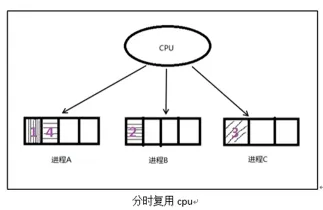
单道程序设计
所有程序一个一个排队执行,若A阻塞,B只能等待
多道程序设计
在管理程序控制之下,多个独立程序相互穿插运行。多道程序设计必须有硬件基础作为保证。
1.3 并发和并行
并行是宏观上并发,微观上串行
1.4 CPU和MMU

存储介质自下而上,容量越小,速度越快。一个寄存器大小为4K。箭头表示一条指令的执行流程,从硬盘的代码文件开始,到内存中执行程序,在存入缓存,写入寄存器,发送到CPU内部处理。
1.5 虚拟内存和物理内存映射关系
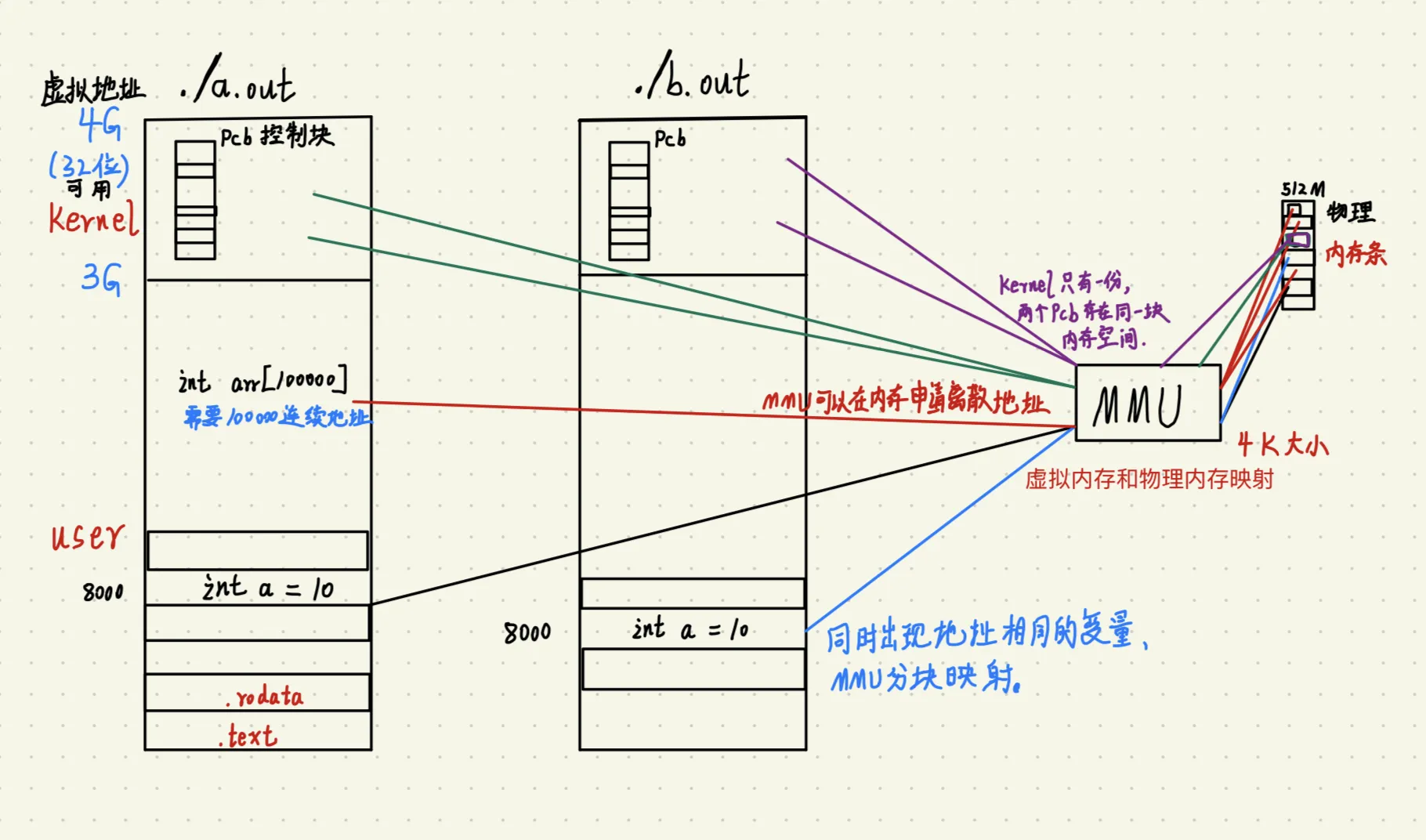
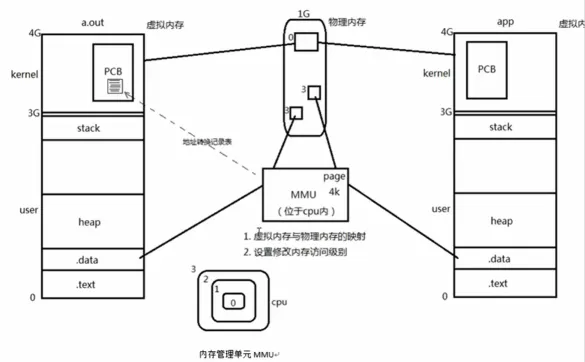
MMU修改内存访问级别,进行权级切换耗费时间,这就是为什么用户空间访问内核空间的过程非常耗时间。
1.6 PCB进程控制块
struct task struct结构体部分内部成员
进程ID(PID)
文件描述符表
进程状态:初始态、就绪态、运行态、挂起态、终止态。
进程切换时需要保存和恢复的一些CPU寄存器
描述虚拟地址空间的信息
描述控制终端的信息
当前工作目录位置
umask掩码 (进程的概念)
信号相关信息资源。
用户id和组id
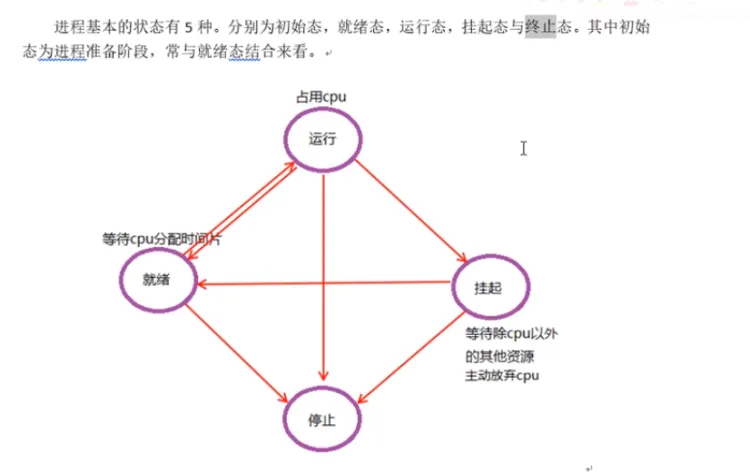
1.7 环境变量
echo $PATH # 查看环境变量path环境变量里记录了一系列的值,当运行一个可执行文件时,系统会去环境变量记录的位置里查找这个文件并执行。
echo $TERM # 查看终端
echo $LANG # 查看语言
env # 查看所有环境变量
进程控制
2- fork 函数
用来创建新进程
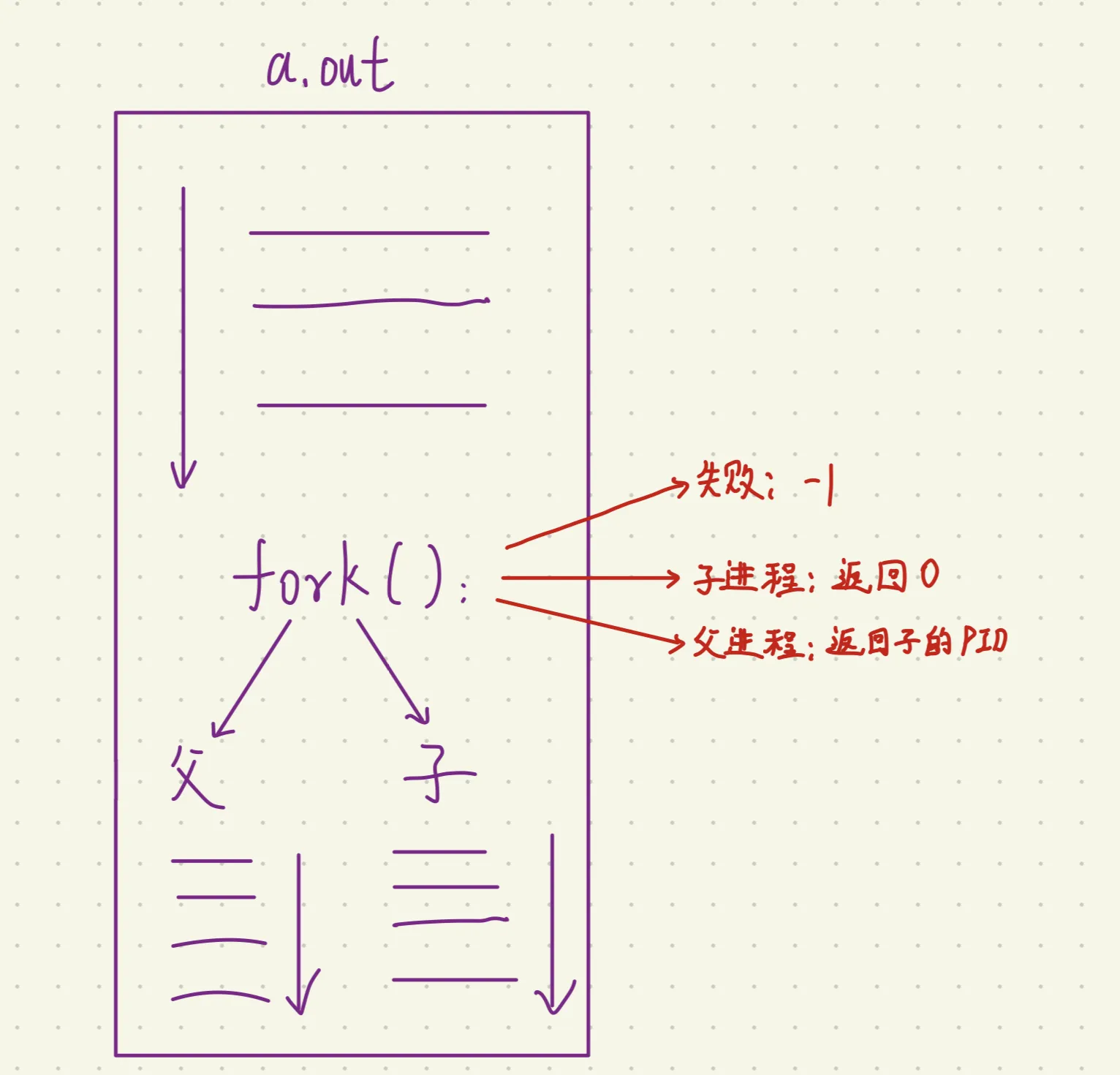
2.1 函数原型
pid_t fork(void);
// 例如:pid_t pid = fork();2.2 返回值
fork() 函数返回两次
一次在父进程中返回子进程的进程ID(PID)
一次在子进程中返回
0
通过这种方式,父进程和子进程可以根据返回值来区分自己是父进程还是子进程。
失败返回
-1
2.3 示例
通过创建进程,打印自己是父进程还是子进程
#include <stdio.h>
#include <stdlib.h>
#include <unistd.h>
#include <string.h>
#include <pthread.h>
int main(int argc, char *argv[])
{
printf("before fork-1-\n");
printf("before fork-2-\n");
printf("before fork-3-\n");
printf("before fork-4-\n");
pid_t pid = fork();
if(pid == -1)
{
perror("fork error");
exit(1);
}
else if(pid == 0)
{
printf("---child is created\n");
}
else if(pid > 0)
{
printf("---parent process: my child is %d\n", pid);
}
printf("==============end of file\n");
return 0;
}2.4 getpid 和 getppid
用来获取进程ID
2.4.1 函数原型
pid_t getpid(); // 获取当前进程id
pid_t getppid(); // 获取当前进程的父进程id2.4.2 示例
分别在子父进程获取当前PID和父进程PID
#include <stdio.h>
#include <stdlib.h>
#include <unistd.h>
#include <string.h>
#include <pthread.h>
int main(int argc, char *argv[])
{
printf("before fork-1-\n");
printf("before fork-2-\n");
printf("before fork-3-\n");
printf("before fork-4-\n");
pid_t pid = fork();
if(pid == -1)
{
perror("fork error");
exit(1);
}
else if(pid == 0)
{
printf("---child process: pid = %d, parent_pid = %d\n", getpid(),getppid());
}
else if(pid > 0)
{
printf("---parent process: my child is %d, my pid = %d, parent_pid = %d\n", pid, getpid(),getppid());
}
printf("==============end of file\n");
return 0;
}

这里父进程的父进程PID表示的是当前bash的PID。
2.5 循环创建多个子进程
通过循环给一个父进程创建5个子进程
#include <stdio.h>
#include <stdlib.h>
#include <unistd.h>
#include <string.h>
#include <pthread.h>
int main(int argc, char *argv[])
{
int i;
pid_t pid;
for (i = 0; i < 5; i++)
{
if ((pid = fork()) == 0) // 这里必须要判断是否为子进程,不然子进程和父进程会一起都创建出子进程
{
break;
}
if(i == 5)
{
sleep(i);
printf("i'm parent\n");
}
else
{
sleep(i);
printf("i'm %dth child\n", i+1);
}
}
return 0;
}2.6 父子进程共享哪些内容
父子进程相同:(0-3G用户空间)
.data段.text段堆
栈
环境变量
用户ID
宿主目录
进程工作目录
信号处理方式
父子进程不同:
进程
idfork返回值各自的父进程
进程创建运行时间
闹钟 ( 定时器 )
未决信号集
原则
读时共享、写时复制------不用在意
父子进程共享:
文件描述符(打开文件的结构体)
mmap映射区(进程间通信)。
2.7 父子进程gdb调试
设置父进程调试路径
set follow-fork-mode parent (默认)设置子进程调试路径
set follow-fork-mode childnote: 设置必须在fork函数调用之前才有效。
3- exec 函数族
当进程调用一种exec函数时,该进程的用户空间代码和数据完全被新程序替换,从新程序的启动例程开始执行。但进程ID不变,换核不换壳。
使进程执行某一程序。成功无返回值,失败返回-1
3.1 execlp函数
借助 PATH 环境变量加载一个进程。一般用于调用系统程序。如:ls、cat等。
3.1.1 函数原型
int execlp(const char *file, const char *arg, ...); 参数从前到后为:文件名,argv[0],argv[1],argv[2]......
因此第二个参数不能写运行程序的第一个参数。
有多个参数,函数结尾必须添加NULL作为哨兵,表示参数结束。
3.1.2 示例
通过execlp让子进程去执行ls命令
#include <stdio.h>
#include <stdlib.h>
#include <unistd.h>
#include <string.h>
#include <pthread.h>
int main(int argc, char *argv[])
{
pid_t pid = fork();
if(pid == -1)
{
perror("fork error");
exit(1);
}
else if(pid == 0) // 子进程
{
execlp("ls","ls","-l","-h",NULL); // 参数为:文件名,argv[0],argv[1],argv[2]......
perror("exec error");
exit(1);
}
else if(pid > 0) // 父进程
{
sleep(1); // 防止bash抢占
printf("im parent");
}
printf("=======================\n");
return 0;3.2 execlp 函数
使用execl来让子程序调用自定义的程序
3.2.1 函数原型
int execl(const char *path, const char *arg, ...); 和execlp不同的是,第一个参数是路径,不是文件名。
这个路径用相对路径和绝对路径都行。
3.2.2 示例
使用execl来让子程序调用test.out程序。
#include <stdio.h>
#include <stdlib.h>
#include <unistd.h>
#include <string.h>
#include <pthread.h>
int main(int argc, char *argv[])
{
pid_t pid = fork();
if(pid == -1)
{
perror("fork error");
exit(1);
}
else if(pid == 0) // 子进程
{
execl("./test.out","./a.out",NULL); // 参数为:文件名,argv[0],argv[1],argv[2]......
// execl("/bin/ls","ls","-l",NULL); // 也可以调用系统命令,加上路径就可以
perror("exec error");
exit(1);
}
else if(pid > 0) // 父进程
{
sleep(1); // 防止bash抢占
printf("im parent");
}
printf("=======================\n");
return 0;
}3.3 exec函数族特性
以下示例是:
写一个程序,使用execlp执行进程查看,并将结果输出到文件里。
要用到open, execlp,dup2
#include <stdio.h>
#include <stdlib.h>
#include <fcntl.h>
#include <unistd.h>
#include <string.h>
#include <pthread.h>
int main(int argc, char *argv[])
{
int fd = open("ps.out", O_WRONLY|O_CREAT|O_TRUNC, 0644);
if(fd < 0)
{
perror("open ps.out error");
exit(1);
}
dup2(fd, STDOUT_FILENO);
execlp("ps","ps","aux",NULL);
perror("execlp error");
// close(fd); // 不会执行
return 0;
}exec函数族一般规律:
exec函数一旦调用成功,即执行新的程序,不返回。只有失败才返回,错误值-1,所以通常我们直接在exec函数调用后直接调用
perror(),和exit()`,无需if判断。
事实上,只有execve是真正的系统调用,其他5个函数最终都调用execve,是库函数,所以execve在man手册第二节,其它函数在man手册第3节。
4- 进程回收
4.1 孤儿进程和僵尸进程
孤儿进程:
父进程先于子进终止,子进程沦为“孤儿进程”,会被
init进程领养。
僵尸进程:
子进程终止,父进程尚未对子进程进行回收,在此期间,子进程为“僵尸进程”。
kill对其无效。这里要注意,每个进程结束后都必然会经历僵尸态,时间长短的差别而已。子进程终止时,子进程残留资源 PCB 存放于内核中,PCB 记录了进程结束原因,进程回收就是回收 PCB 。回收僵尸进程,得
kill它的父进程,让孤儿院去回收它。
4.2 wait 回收子进程
4.2.1 wait 函数原型
回收子进程退出资源, 阻塞回收任意一个。
pid_t wait(int *status);参数:(传出) 回收进程的状态。
返回值:
成功: 回收进程的 pid
失败: -1,errno
4.2.2 函数作用
阻塞等待子进程退出
清理子进程残留在内核的
pcb资源通过传出参数,得到子进程结束状态
4.2.3 获取子进程退出值和异常终止信号
获取子进程正常终止值:
WIFEXITED(status) --> 为真 -->调用 WEXITSTATUS(status) --> 得到 子进程 退出值。
获取导致子进程异常终止信号:
WIFSIGNALED(status) --> 为真 -->调用WTERMSIG(status) --> 得到 导致子进程异常终止的信号编号。
4.2.4 示例
捕获程序异常终止的信号并打印
#include <stdio.h>
#include <stdlib.h>
#include <fcntl.h>
#include <unistd.h>
#include <string.h>
#include <pthread.h>
#include <sys/wait.h>
int main(void)
{
pid_t pid, wpid;
int status;
pid = fork();
if(pid == 0)
{
printf("---child, my id= %d, going to sleep 4s\n", getpid());
sleep(4);
printf("-------------child die--------------\n");
return 73; // 子进程退出值
}
else if(pid > 0)
{
wpid = wait(&status); // 如果子进程未终止,父进程阻塞在这个函数上
if(wpid == -1)
{
perror("wait error");
exit(1);
}
if(WIFEXITED(status)) // 为真,说明子进程正常终止.
{
printf("child exit with %d\n", WEXITSTATUS(status)); // 打印退出值
}
if (WIFSIGNALED(status)) //为真,说明子进程是被信号终止.
{
printf("child kill with signal %d\n", WTERMSIG(status)); // 导致子进程异常终止的信号编号
}
}
else {
perror("fork");
return 1;
}
return 0;
} 4.3 waitpid回收子进程
4.3.1 waitpid函数原型
pid_t waitpid(pid_t pid, int *status, int options);指定某一个进程进行回收。可以设置非阻塞。
waitpid(-1, &status, 0) == wait(&status);
参数
pid:指定回收某一个子进程pid> 0: 回收指定ID的子进程pid-1:回收任意子进程0:回收和当前调用waitpid一个组的所有子进程< -1: 回收指定进程组内的任意子进程
status:(传出) 回收进程的状态。options:WNOHANG指定回收方式为,非阻塞。
返回值
> 0: 表成功回收的子进程 pid0: 函数调用时, 参数3 指定了WNOHANG, 并且,没有子进程结束。-1: 失败。errno
4.3.2 示例
回收指定子进程。
#include <stdio.h>
#include <stdlib.h>
#include <fcntl.h>
#include <unistd.h>
#include <string.h>
#include <pthread.h>
#include <sys/wait.h>
int main(int argc, char *argv[])
{
int i;
pid_t pid, wpid,tmpid;
for(i = 0; i<5; i++)
{
pid = fork();
if(pid == 0) // 子进程不fork()
{
break;
}
if(i == 2)
{
tmpid = pid;
printf("pid = %d\n", tmpid);
}
}
if(5 == i) // 父进程, 从 表达式 2 跳出
{
sleep(5);
printf("i am parent , before waitpid, pid = %d \n", tmpid);
wpid = waitpid(tmpid, NULL, WNOHANG); // 指定一个进程回收,不阻塞
// wpid = waitpid(tmpid, NULL, 0); // 指定一个进程回收,阻塞
if (wpid > 0)
{
printf("child pid = %d has finished\n", wpid);
}
else if(wpid == 0)
{
printf("child pid = %d not finished\n", wpid);
}
else if(wpid == -1)
{
perror("waitpid error");
exit(1);
}
}
else // 子进程, 从 break 跳出
{
sleep(i);
printf("I am %dth child, pid= %d\n", i+1, getpid());
}
return 0;
}4.4 waitpid 回收多个子进程
一次wait/waitpid函数调用,只能回收一个子进程。
下面的示例展示了循环回收多个子进程。
#include <stdio.h>
#include <stdlib.h>
#include <fcntl.h>
#include <unistd.h>
#include <string.h>
#include <pthread.h>
#include <sys/wait.h>
// 回收多个子进程
int main(int argc, char *argv[])
{
int i;
pid_t pid, wpid;
for (i = 0; i < 5; i++) {
pid = fork();
if (pid == 0) { // 循环期间, 子进程不 fork
break;
}
}
if (5 == i) { // 父进程, 从 表达式 2 跳出
/*
while ((wpid = waitpid(-1, NULL, 0))) { // 使用阻塞方式回收子进程
printf("wait child %d \n", wpid);
}
*/
while ((wpid = waitpid(-1, NULL, WNOHANG)) != -1) { //使用非阻塞方式,回收子进程.
if (wpid > 0) {
printf("wait child %d \n", wpid);
} else if (wpid == 0) {
sleep(1);
continue;
}
}
} else { // 子进程, 从 break 跳出
sleep(i);
printf("I'm %dth child, pid= %d\n", i+1, getpid());
}
return 0;
} 4.5 wait 和 waitpid 总结
总结:
wait、waitpid 一次调用,回收一个子进程。
想回收多个用while
5- 进程间通信
5.1 进程间通信的方式
IPC进程间通信的常用方式:
管道:使用简单
信号:开销最小
mmap映射:可以用在非血缘关系进程间socket( 本地套接字 ):稳定性最高,但是实现最麻烦
5.2 管道通信
5.2.1 原理与特性
原理:内核借助环形队列机制,使用内核缓冲区实现。
特性:
1. 伪文件
2. 管道中的数据只能一次读取
3. 数据在管道中,只能单向流动
局限性:
1. 数据不能自己写,自己读
2. 数据不可以反复读
3. 双向半双工通信(数据可以双向流动,但是不能同时两个方向流动)
4. 只有血缘关系间的进程之间可以使用
5.2.2 管道使用方法
pipe函数作用:创建并打开管道
函数原型:
int pipe(int fd[2]);参数:
fd[0]: 读端。fd[1]: 写端。
返回值:
成功:
0失败:
-1,errno
图示
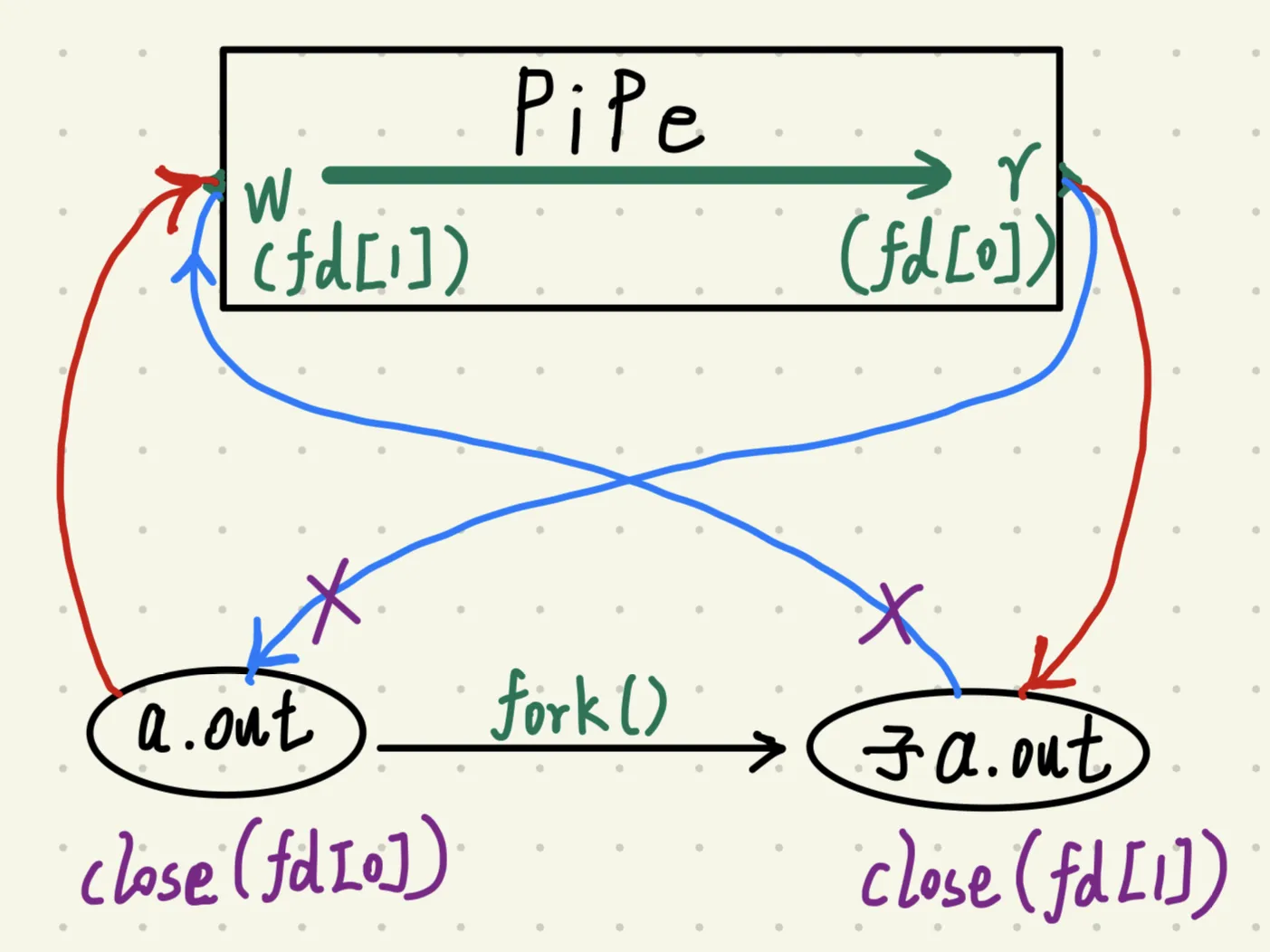
示例
父进程往管道里写,子进程从管道读,然后打印读取的内容
#include <stdio.h>
#include <stdlib.h>
#include <fcntl.h>
#include <unistd.h>
#include <string.h>
#include <pthread.h>
#include <sys/wait.h>
void sys_err(const char *str)
{
perror(str);
exit(1);
}
int main(int argc, char* argv[])
{
int ret, ret_read, ret_write;
int fd[2];
pid_t pid;
char *str = "hello pipe()\n";
char buf[1024];
ret = pipe(fd);
if(ret == -1)
{
sys_err("pipe error");
}
pid = fork();
if(pid > 0)
{
close(fd[0]); // 父进程关闭读端
sleep(3);
ret_write = write(fd[1],str,strlen(str));
printf("parent write ret = %d \n", ret_write);
sleep(1);
close(fd[1]);
}
else if(pid == 0)
{
close(fd[1]); // 子进程关闭写端
ret_read = read(fd[0], buf, sizeof(buf));
printf("child read ret = %d \n", ret_read);
write(STDOUT_FILENO, buf, ret_read);
close(fd[0]);
}
return 0;
}5.2.3 管道读写行为
读管道:
管道有数据,
read返回实际读到的字节数。管道无数据:
无写端,
read返回0 (类似读到文件尾)有写端,
read阻塞等待。
写管道:
无读端, 异常终止。 (
SIGPIPE导致的)有读端:
管道已满, 阻塞等待
管道未满, 返回写出的字节个数。
5.2.4 父子间进程通信示例
使用管道实现父子进程间 ls | wc -l 通信
ls命令是用于列出目录中的文件和子目录的命令wc -l命令用于统计输入信息的行数
要求
假定父进程实现
wc,子进程实现lsls命令正常会将结果集写到stdout,但现在会写入管道写端wc -l命令正常应该从stdin读取数据,但此时会从管道的读端读。要用到
pipedup2exec
#include <stdio.h>
#include <stdlib.h>
#include <fcntl.h>
#include <unistd.h>
#include <string.h>
#include <pthread.h>
#include <sys/wait.h>
void sys_err(const char *str)
{
perror(str);
exit(1);
}
int main(int argc, char* argv[])
{
int ret;
int fd[2];
pid_t pid;
char buf[1024];
ret = pipe(fd);
if(ret == -1)
{
sys_err("pipe error");
}
pid = fork();
if(pid == -1)
{
sys_err("fork error");
}
else if(pid > 0) // 父进程
{
close(fd[1]); // 父进程关闭写端
dup2(fd[0], STDIN_FILENO);
execlp("wc", "wc", "-l", NULL);
sleep(1);
close(fd[0]);
}
else if (pid == 0) // 子进程
{
close(fd[0]); // 子进程关闭读端
dup2(fd[1], STDOUT_FILENO);
execlp("ls","ls",NULL);
close(fd[1]);
}
return 0;
}5.2.5 兄弟进程间通信
示例:
要求使用 “循环创建N个子进程的模型” 来创建兄弟进程,使用循环因子i标识,注意管道读写行为
兄:
ls;弟:
wc -l;父:等待回收子进程;
#include <stdio.h>
#include <stdlib.h>
#include <fcntl.h>
#include <unistd.h>
#include <string.h>
#include <pthread.h>
#include <sys/wait.h>
void sys_err(const char *str)
{
perror(str);
exit(1);
}
int main(int argc, char* argv[])
{
int ret, i;
int fd[2];
pid_t pid;
char buf[1024];
ret = pipe(fd);
if(ret == -1)
{
sys_err("pipe error");
}
for (i = 0; i < 2; i++)
{
if ((pid = fork()) == 0) // 判断是否为子进程,子进程不fork
{
break;
}
if(pid == -1)
{
sys_err("fork error");
}
if(pid == 0) // 子进程出口
{
break;
}
}
if(i == 2) // 父进程
{
close(fd[1]); // 父进程关闭写端
close(fd[0]); // 父进程关闭读端
wait(NULL);
wait(NULL);
printf("children all finished! \n");
}
if (i == 0) // 兄进程
{
close(fd[0]); // 兄进程关闭读端
dup2(fd[1], STDOUT_FILENO);
execlp("ls","ls",NULL);
close(fd[1]);
}
if (i == 1) // 弟进程
{
close(fd[1]); // 弟进程关闭写端
dup2(fd[0], STDIN_FILENO);
execlp("wc", "wc", "-l", NULL);
sleep(1);
close(fd[0]);
}
return 0;
}5.2.6 多个读写端操作管道和管道缓冲区大小
一个读端多个写端,需要调控写入顺序,保证同一时间只有一个写端向管道内写数据,同时调整读端的时间,避免漏掉数据。
管道缓冲区大小默认4096(4K)
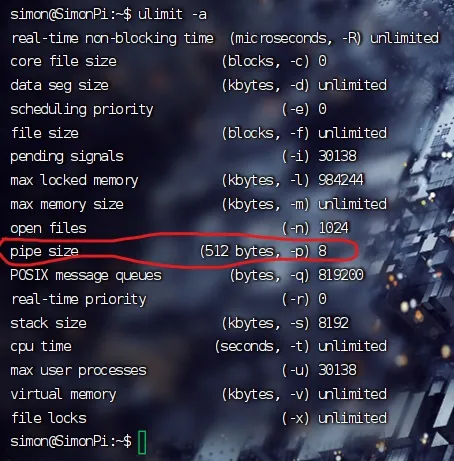
5.3 FIFO命名管道
可以用于无血缘关系的进程间通信。
fifo操作起来像文件
5.3.1 FIFO管道使用方法
mkfifo函数作用:创建并打开管道
函数原型:
int mkfifo(const char *pathname, mode_t mode);参数:
pathname: 要创建的命名管道的路径名mode: 创建的命名管道的权限模式。通常使用八进制表示的权限值,例如0666open fifo O_RDONLY: 读端。open fifo O_WRONLY: 写端。
返回值:
成功:
0失败:
-1,errno
示例
非血缘关系进程,一个写
fifo,一个读fifo,操作起来就像文件一样的写端:
#include <stdio.h> #include <stdlib.h> #include <fcntl.h> #include <unistd.h> #include <string.h> #include <pthread.h> #include <sys/stat.h> #include <sys/wait.h> #define FIFO_PATH "myfifo" void sys_err(const char *str) { perror(str); exit(1); } int main(int argc, char *argv[]) { int fd, i = 0; char buf[4096]; mkfifo(FIFO_PATH, 0666); fd = open(FIFO_PATH, O_WRONLY); if(fd == -1) { sys_err("open error"); } // 写数据 while(1) { sprintf(buf,"hello myfifo %d \n", i++); write(fd, buf, strlen(buf)); // 向管道写数据 sleep(1); } close(fd); // 删除命名管道 unlink(FIFO_PATH); return 0; }读端:
#include <stdio.h> #include <stdlib.h> #include <fcntl.h> #include <unistd.h> #include <string.h> #include <pthread.h> #include <sys/stat.h> #include <sys/wait.h> #define FIFO_PATH "myfifo" void sys_err(const char *str) { perror(str); exit(1); } int main(int argc, char *argv[]) { // 打开管道进行读取 int fd, len; char buf[4096]; fd = open(FIFO_PATH, O_RDONLY); if(fd == -1) { sys_err("open error"); } // 读取数据 while(1) { len = read(fd, buf, sizeof(buf)); // 从管道读数据 write(STDOUT_FILENO, buf, len); sleep(1); // 多个读端时应该增加睡眠秒数,放大效果 } close(fd); return 0; }一个读端,多个写端或者一个写端多个读端都是可以的,在一个写端多个读端时,数据一旦被读走就没了,就是数据不可重复读取。所以多个读端的并集才是写端的写入数据。
5.3.2 文件实现进程间通信
文件通信,有没有血缘关系都行
只是有血缘关系的进程对于同一个文件,使用的同一个文件描述符,
没有血缘关系的进程,对同一个文件使用的文件描述符可能不同。
这些都不是问题,打开的是同一个文件就行。
5.4 存储映射I/O
5.4.1 mmap函数
创建共享内存映射
函数原型:
void *mmap(void *addr, size_t length, int prot, int flags, int fd, off_t offset);参数:
addr: 指定映射区的首地址。通常传【NULL】,表示让系统自动分配length:共享内存映射区的大小。(【<= 】文件的实际大小)prot: 共享内存映射区的读写属性。PROT_READ、PROT_WRITE、PROT_READ|PROT_WRITE、PROT_EXEC
flags: 标注共享内存的共享属性。MAP_SHARED修改会反映到磁盘上MAP_PRIVATE修改不反映到磁盘上MAP_ANONYMOUS匿名映射,不用手动依赖文件
fd: 用于创建共享内存映射区的那个文件的 文件描述符。offset:默认0,表示映射文件全部。偏移位置。需是 【4k 的整数倍】。
返回值:
成功:映射区的首地址。
失败:
MAP_FAILED (void*(-1)),errno
5.4.2 munmap函数
释放映射区。
函数原型
#include <sys/mman.h> int munmap(void *addr, size_t length);参数:
addr:mmap的返回值length:大小
5.4.3 mmap示例
使用mmap创建一个映射区(共享内存),并往映射区里写入内容并打印出来。
#include <stdio.h>
#include <stdlib.h>
#include <fcntl.h>
#include <unistd.h>
#include <string.h>
#include <pthread.h>
#include <sys/wait.h>
#include <sys/mman.h> // 需要引入头文件
void sys_err(const char *str) // 错误处理函数
{
perror(str);
exit(1);
}
int main(int argc, char* argv[])
{
// 打开文件
int fd = open("testmap", O_RDWR|O_CREAT|O_TRUNC, 0644);
if(fd == -1)
{
sys_err("open error");
}
// 扩展文件大小
/*
lseek(fd, 20, SEEK_END); // 这两个函数等价于ftruncate()函数
write(fd, "\0", 1);
*/
ftruncate(fd, 20);
int len = lseek(fd, 0, SEEK_END);
// 映射内存
char *p = NULL;
p = mmap(NULL, len,PROT_READ|PROT_WRITE, MAP_SHARED, fd, 0);
if(p == MAP_FAILED)
{
sys_err("mmap error");
}
// 使用 p 对文件进行读写操作
strcpy(p, "hello mmap"); // 写操作
printf("-----%s \n", p); // 读操作
// 释放映射区
int ret = munmap(p, len);
if(ret == -1)
{
sys_err("mnmap error");
}
return 0;
}5.4.4 mmap使用注意事项
用于创建映射区的文件大小为 0,实际指定非0大小创建映射区,出 “总线错误”。
用于创建映射区的文件大小为 0,实际指定0大小创建映射区, 出 “无效参数”错误。
用于创建映射区的文件读写属性为,只读。映射区属性为 读、写。 出 “无效参数”错误。
创建映射区,需要
read权限。当访问权限指定为 “共享”MAP_SHARED时,mmap的读写权限,应该 <= 文件的open权限。只写不行,至少需要读。文件描述符
fd,在mmap创建映射区完成即可关闭。后续访问文件,用地址访问。offset必须是 4096的整数倍。(MMU 映射的最小单位 4k )对申请的映射区内存,不能越界访问。
munmap用于释放的 地址,必须是mmap申请返回的地址。映射区访问权限为 “私有”
MAP_PRIVATE, 对内存所做的所有修改,只在内存有效,不会反应到物理磁盘上。映射区访问权限为 “私有”
MAP_PRIVATE, 只需要open文件时,有读权限,用于创建映射区即可。mmap函数的保险调用方式:fd = open("文件名", O_RDWR); mmap(NULL, 有效文件大小, PROT_READ|PROT_WRITE, MAP_SHARED, fd, 0);
5.4.5 有血缘父子进程间的mmap通信
要求:对比全局变量
父进程 先 创建映射区。
open( O_RDWR)mmap( MAP_SHARED );指定
MAP_SHARED权限fork()创建子进程。一个进程读, 另外一个进程写。
#include <stdio.h>
#include <stdlib.h>
#include <fcntl.h>
#include <unistd.h>
#include <string.h>
#include <pthread.h>
#include <sys/wait.h>
#include <sys/mman.h> // 需要引入头文件
int var = 100;
void sys_err(const char *str) // 错误处理函数
{
perror(str);
exit(1);
}
int main(int argc, char* argv[])
{
int *p;
pid_t pid;
// open file
int fd = open("temp", O_RDWR|O_CREAT|O_TRUNC,0644);
if(fd == -1)
{
sys_err("open error");
}
ftruncate(fd, 4);
// mmap
// p = (int *)mmap(NULL, 4, PROT_READ|PROT_WRITE, MAP_SHARED, fd, 0); // shared
p = (int *)mmap(NULL, 4, PROT_READ|PROT_WRITE, MAP_PRIVATE, fd, 0); // private
if(p == MAP_FAILED)
{
sys_err("mmap error");
}
// close fd
close(fd);
// creat fork()
pid = fork();
if(pid == 0) // son
{
*p = 7000;
var = 1000;
printf("child, *p = %d, var = %d \n", *p, var);
}
if(pid > 0) // father
{
sleep(1);
printf("parent, *p = %d, var = %d \n", *p, var);
wait(NULL);
int ret = munmap(p, 4);
if(ret == -1)
{
sys_err("munmap error");
}
}
return 0;
}5.4.6 无血缘父子进程间的mmap通信
写端
// WRITE
#include <stdio.h>
#include <stdlib.h>
#include <fcntl.h>
#include <unistd.h>
#include <string.h>
#include <pthread.h>
#include <sys/wait.h>
#include <sys/mman.h> // 需要引入头文件
struct student
{
int id;
char name[256];
int age;
};
void sys_err(const char *str) // 错误处理函数
{
perror(str);
exit(1);
}
int main(int argc, char* argv[])
{
struct student stu = {1, "xiaoming", 18};
struct student *p;
// open file
int fd = open("temp", O_RDWR|O_CREAT|O_TRUNC,0644);
if(fd == -1)
{
sys_err("open error");
}
ftruncate(fd, sizeof(stu));
// mmap
p = mmap(NULL, sizeof(stu), PROT_READ|PROT_WRITE, MAP_SHARED, fd, 0);
if(p == MAP_FAILED)
{
sys_err("mmap error:");
}
// close fd
close(fd);
// write
while(1)
{
memcpy(p, &stu, sizeof(stu));
stu.id++;
stu.age++;
sleep(1);
}
munmap(p, sizeof(stu));
return 0;
}读端
// READ
#include <stdio.h>
#include <stdlib.h>
#include <fcntl.h>
#include <unistd.h>
#include <string.h>
#include <pthread.h>
#include <sys/wait.h>
#include <sys/mman.h> // 需要引入头文件
struct student
{
int id;
char name[256];
int age;
};
void sys_err(const char *str) // 错误处理函数
{
perror(str);
exit(1);
}
int main(int argc, char* argv[])
{
struct student stu;
struct student *p;
// open file
int fd = open("temp", O_RDONLY);
if(fd == -1)
{
sys_err("open error");
}
// mmap
p = mmap(NULL, sizeof(stu), PROT_READ, MAP_SHARED, fd, 0);
if(p == MAP_FAILED)
{
sys_err("mmap error:");
}
// close fd
close(fd);
// read
while(1)
{
printf("id = %d, name = %s, age = %d \n", p->id, p->name, p->age);
sleep(1);
}
munmap(p, sizeof(stu));
return 0;
}无血缘关系进程间通信。
mmap:数据可以重复读取。内容被读走之后不会消失,
如果读进程的读取时间间隔短,它会读到很多重复内容,因为写进程没来得及写入新内容。
fifo:数据只能一次读取。
5.4.7 mmap匿名映射区
无须依赖于一个文件即可创建映射区。只能用于血缘关系进程间通信。
代码:
使用MAP_ANONYMOUS 或者 MAP_ANON宏。
p = (int *)mmap(NULL, size, PROT_READ | PROT_WRITE, MAP_PRIVATE | MAP_ANONYMOUS, -1, 0);- 感谢你赐予我前进的力量



